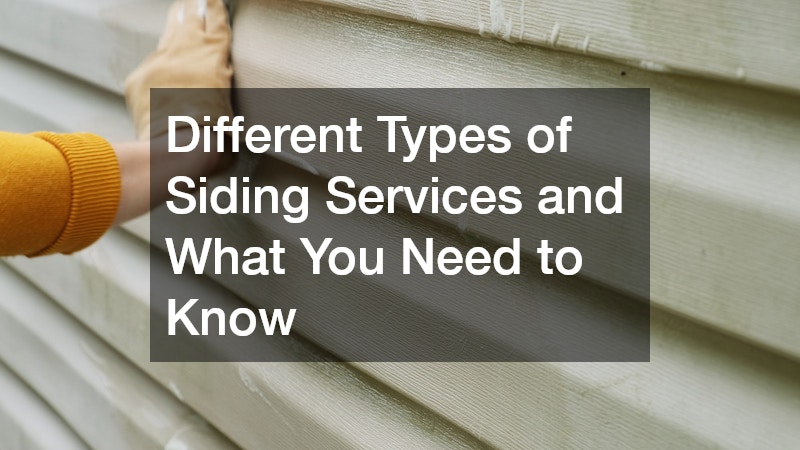When it comes to protecting and enhancing the appearance of your home, siding plays a vital role. Not only does it shield your property from harsh weather and moisture, but it also greatly impacts your home’s curb appeal and energy efficiency. Whether you’re renovating or building from scratch, understanding the different types of siding services can help you make an informed choice. Below, we explore the most common siding options available, the benefits they offer, and what you should consider before investing in siding services.
Understand Vinyl Siding
Vinyl siding is one of the most popular choices in America due to its affordability, durability and ease of maintenance. It comes in a wide range of colours and textures, including styles that mimic the appearance of wood, stone and more.
This type of siding is cost-effective and widely available. It is resistant to pests and rot and requires minimal maintenance—just occasional cleaning. Additionally, vinyl siding can come with insulation options that improve your home’s energy efficiency.
However, vinyl siding may not be the best option for areas prone to extreme heat, as it can warp or fade over time. While it is practical, it lacks the high-end aesthetic of materials like wood or stone.
Explore Fibre Cement Siding
Fibre cement siding is a blend of cement, sand and cellulose fibres. It’s known for its impressive durability and fire resistance, making it ideal for homes that face variable weather conditions, including high heat, storms and bushfire zones.
Fibre cement siding is fire-resistant and termite-proof. It can mimic the look of wood, stucco or masonry without requiring intensive upkeep. This material is built to withstand harsh weather and UV exposure, with a lifespan that can stretch up to 50 years.
On the downside, fibre cement is heavier and requires professional installation. The upfront cost is higher, but its longevity and strength often make it worth the investment.
Choose Timber Siding for a Natural Look
Timber siding, often referred to as weatherboard or cladding, provides a classic, natural aesthetic. It adds warmth and character to both traditional and modern homes. In the US, common timber options include cedar, blackbutt and spotted gum.
The appearance of real wood is timeless and offers a unique, organic charm that other materials struggle to replicate. Timber is also renewable and considered environmentally friendly. It can be painted or stained in virtually any colour, offering design flexibility.
However, timber requires regular maintenance. To protect it from termites, rot and UV damage, homeowners must commit to sealing, staining or repainting. It also tends to be more expensive and less fire-resistant compared to alternatives like fibre cement or metal siding.
Consider Aluminium or Steel Siding
Metal siding, which includes aluminium and steel options, is a durable choice that’s becoming increasingly popular for residential and commercial properties alike. It’s particularly favoured in coastal and bushfire-prone regions.
Aluminium and steel are long-lasting and stand up well against pests, rot and fire. They are also recyclable, making them a sustainable choice for eco-conscious homeowners. In addition, their strength makes them ideal for extreme climates and regions with high bushfire risk.
That said, metal siding can come with a higher initial price tag. It is also prone to denting and can be noisy during heavy rain or hail. On its own, metal siding offers limited insulation, so you may need to incorporate additional thermal barriers.
Try Brick and Stone Veneer Siding
Brick and stone veneer siding offers the luxurious appearance of solid masonry without the weight or cost. These options are often used as accents or as full exterior coverings, depending on the architectural style of the home.
One of the greatest strengths of brick and stone veneer is their aesthetic appeal. They lend a timeless and upscale feel to any home, while also providing excellent protection against the elements. These materials are resistant to fire, pests and moisture, and require minimal maintenance over time.
Installation, however, can be labour-intensive and requires skilled tradespeople. The upfront costs are generally higher, and because veneers are typically applied over a structural wall, they may not offer as much insulation unless additional materials are added.
Know When to Call a Professional
Choosing the right type of siding is only half the battle. Proper installation is crucial to ensuring the longevity and performance of your exterior. A professional siding contractor will not only help you select the best material for your climate, budget and aesthetic preferences but also ensure it’s installed according to American building standards.
Whether you’re updating an old façade or building a new home, it pays to consult with a professional. They can provide insight into local regulations, bushfire ratings, weather considerations and long-term maintenance requirements.
Siding is more than just an exterior finish; it’s an investment in the safety, beauty and value of your home. From affordable vinyl to elegant brick veneer, each type of siding comes with its own set of benefits and considerations. By understanding the different materials and services available, you can make an informed decision that enhances your property for years to come.




